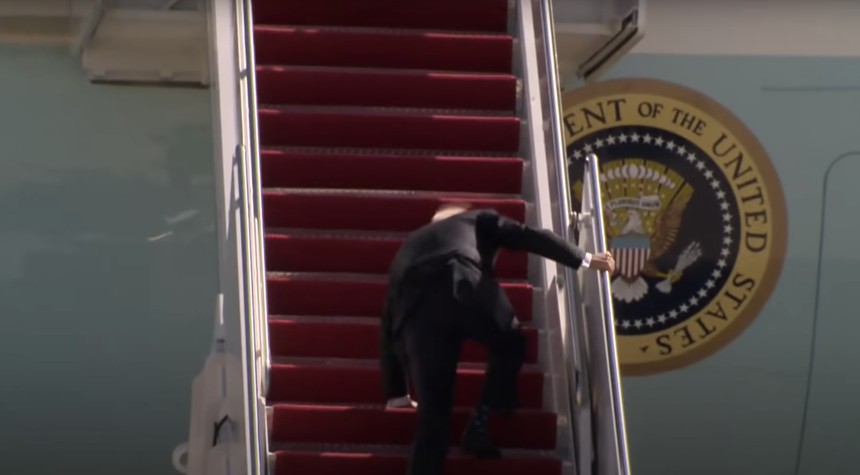Several Unnecessary Crises Culminate at Once – and the Biden COVID Mandates Are Directly to Blame
(The opinions expressed in guest op-eds are those of the writer and do not necessarily represent the views of RedState)
It’s becoming abundantly — and painfully — clear that Joe Biden and his benefactors in organized labor have wreaked enough havoc in 19 months to haunt this country for decades.
First, the president allowed the nation’s teachers’ unions to dictate school reopening policies during the COVID lockout. The politically motivated shutdowns fought for by American Federation of Teachers President Randi Weingarten and her fellow teachers’ union leaders led directly to an epidemic of substance abuse and a 99 percent increase in self-harm and suicide attempts among U.S. teenagers who would otherwise have been in school interacting with their friends and classmates.
Social distancing at lunch, weeks languishing in plexiglass cubicles and trying to learn when you can’t see or hear your teacher and classmates behind masks had a devastating impact on students’ mental and emotional well-being. Now we’re learning through the National Assessment of Educational Progress (NAEP) test results that the COVID overreaction from teachers’ unions and state and local governments has erased two decades’ worth of progress in math and reading.
What the unions and their sock puppets in elected office have done to American children is criminal.
But wait, there’s more.
It may take even longer to fully document the impact on Americans Biden’s panic-motivated vaccine mandate is having and will have on the country, but early indications are ominous.
The vaccine mandate affected members of the U.S. military and federal government employees, federal contractors, healthcare professionals, and employers of 100 or more workers.
In one of his many doomsaying speeches, Biden declared last September, “We’ve been patient, but our patience is wearing thin, and your refusal has cost all of us.”
Now it’s his mandate that is costing all of us.
Employers didn’t know if he — or they — even had the authority to require a person put something unwanted in their body as a condition of employment. Would the mandate be upheld? If not, how long could they hold out without terminating employees against their will?
If employers refused to fire valued employees because of a half-baked mandate, would the government really impose financially devastating, punitive fines designed to bankrupt the offender?
Labor unions in both the public and private sectors responded with characteristic hypocrisy. The AFL-CIO and the National Nurses United and American Nurses Association, for example, embraced the mandates — regardless of their members’ wishes.
There were a handful of notable exceptions. The Brotherhood of Locomotive Engineers and Trainmen and the International Association of Sheet Metal, Air, Rail and Transportation Workers, for example, went to court on behalf of its members’ right to decline the vaccine without going through the negotiating process.
Likewise, the Minnesota Nurses Association surveyed its members and released a statement the same week as Biden’s “patience wearing thin” threat and concluded:
“After years of deliberate under staffing, increasing threats of workplace violence and lack of autonomy over their profession, the same healthcare workers who have been caring for us in our darkest hours are exhausted and leaving the profession early or for less demanding work. We question the timing of the impending vaccine mandates and believe these mandates will continue to exacerbate staffing shortages. It’s time for our healthcare system to get back to healing the patient and upholding their responsibility to workers.”
On Sept. 12, however, roughly 15,000 nurses in Minnesota began a strike in protest of stalled contract negotiations and “concerns over staffing and retention, wages and patient care”.
The strike is expected to continue through Wednesday and is believed to be the largest-ever strike of private-sector nurses in the country. The walkout includes nurses from 16 hospitals representing seven different hospital systems.
Regardless of what happens after Sept. 14, don’t expect this to be the last major strike among healthcare professionals, nor will it be the longest.
America is now intently watching the railway industry to see if it will head into a strike this week, as well. If a deal is not reached this week, a national strike is scheduled to commence on Friday.
Americans need that like they need a hole in the head.
Roughly 40 percent of the nation’s long-distance trade moves by rails. If a strike idles 7,000 trains a day, that’s a $2 billion hit to the U.S. economy, not to mention untold perishable food waste, disruption in delivery of medical and healthcare supplies, delays in fuel transport, and increasing prices during a time Americans desperately need an end to the skyrocketing inflation.
There’s a lot of finger-pointing going around. Were the private companies too quick to enforce an untested vaccine mandate? Should more unions have fought for their members not to lose their jobs?
One thing’s for sure: The crippling strikes we’re seeing in crucial industries are but the latest manifestation of the Faustian Bargain agreed to between Joe Biden and his union cronies in 2020.





Post a Comment